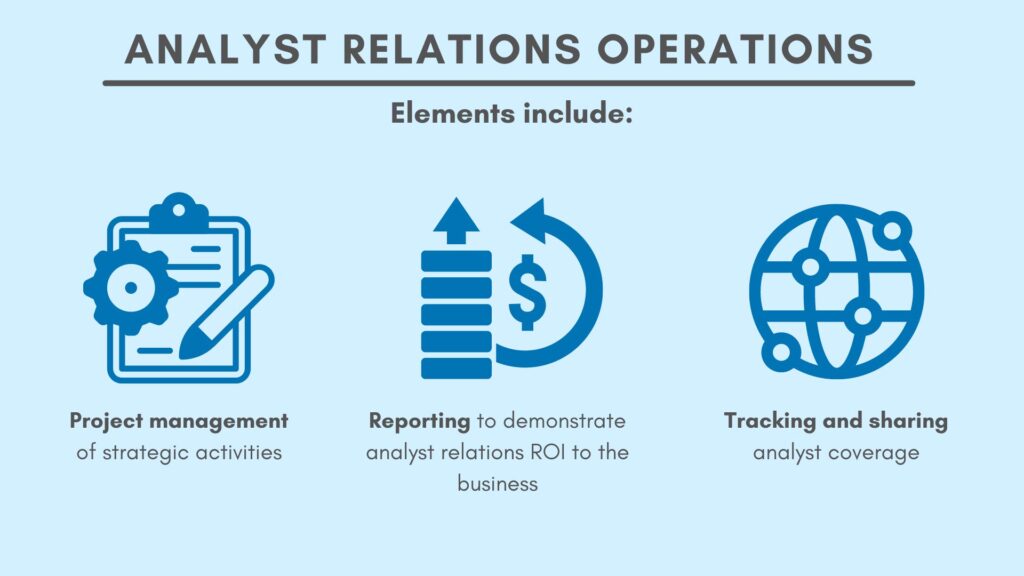The to-do list of an analyst relations practitioner is practically-never ending. With so many competing and high-priority activities — including multiple (often simultaneous) evaluations, product launches, analyst days and more — key operational components of AR often aren’t addressed thoroughly… if they’re addressed at all. But AR operations is a critical area: It helps support and underpin the management of processes that AR programs need to run efficiently and effectively, and enables you to more easily demonstrate ROI for analyst relations.
What is AR operations?
While analyst relations operations can encompass many activities at varying degrees of complexity, based on the needs of each company, we’ll look at the most fundamental aspects.

Analyst relations operations develops, implements and manages processes around key elements that are core to the success of an AR program. These elements often include:
-
Project management of strategic activities
-
Reporting to demonstrate analyst relations ROI to the business
-
Tracking and sharing analyst coverage
Let’s look at each area in greater depth and how AR operations professionals address it.
#1 — Project management of strategic activities
With effective project management, AR teams can more easily track requirements and milestones, execute on key activities, foster collaboration and accountability, and drive better outcomes. In AR operations, there are often opportunities to optimize project management in areas including: analyst evaluations, analyst events and analyst relationship development. For example:
-
Analyst evaluations — Managing one evaluation is complex and time-consuming, let alone multiple ones. Here, it’s important to create detailed steps to track progress on all components – from pulling in experts across the business to complete the questionnaire, to developing (and conducting) the briefing and demo, to tracking and submitting client references, to fact-checking the draft (sometimes managing potential objections), to promoting the published report (which can encompass sales enablement), and more. Spreadsheets can be onerous for all this; instead, the right software can help you stay organized, ping collaborators, monitor activity by stage, and even view the history of an evaluation year-over-year. You can also easily track and share results of your evaluation efforts.
-
Analyst events — Whether they’re large or small, analyst events require a lot of effort and organization. AR operational activities often include finding key influencers who should be invited, creating and sharing invitations, scheduling 1:1 meetings (without double-booking people or spaces), and creating event briefing books. Technology can help here too: Check out how Oracle coordinates analyst activities at CloudWorld and how Hewlett Packard Enterprise (HPE) drives success at HPE Discover.
-
Analyst relationship development — Fostering mutually beneficial relationships with analysts is a process that takes time. Along the way, the AR operations function should centrally track interactions with key analysts, record and follow up on analyst insights, monitor and report on trends in analyst sentiment, and track and share analyst coverage with the business.
#2 — Reporting to demonstrate analyst relations ROI
Analyst relations is under constant pressure to demonstrate ROI. The AR operations function reports quantitative and qualitative activity data to help inform both the analyst relations program and the rest of the business, and prove return on investment.
For example, for the business, reporting can help stakeholders understand what the AR program has delivered, the analysts’ perspective on the business, how interactions are helping evolve and influence analysts’ sentiment, where external messaging may need work, and how your analyst coverage compares to competitors’ across key topics.
For AR operations pros, it’s important to have access to flexible and interactive reporting tools that let you save (and re-run) reports across customizable parameters, and enable you to do a “deep dive” into the data that’s powering the report. And because stakeholders sometimes request reports with little advance notice, it’s critical to be able to generate reports quickly as well.
#3 — Tracking and sharing analyst commentary and coverage
Tracking what analysts are saying is important to almost all functions of the business. Sales teams need to understand how a company and its competitors are being discussed in the market, and often share — and address feedback from — analyst reports with prospects. Marketing and communications teams can leverage what analysts are saying in company collateral, including marketing brochures, press releases and thought-leadership articles. Some companies even use analyst commentary in investor relations calls to demonstrate their company’s strengths. Across the business, evaluation outcomes are also particularly important and often a question in client RFPs.
So, for AR operations teams, it’s important to be on top of what analysts are saying — relative to your company, competitors and your market in general. The AR operations function often seeks ways to efficiently monitor analyst coverage and commentary across mediums: reports, blog posts, quotes in the media, and social platforms. AR operations pros also look for ways to efficiently glean insights and package them in ways that are useful to the business.
Why does AR operations matter? How do you show success?
Even if you’re just getting started, there are numerous benefits to well-executed AR operations. Arguably the most important is being able to demonstrate ROI to the business: especially key in cost-cutting environments.
Once you establish a basic level of reporting (e.g., with qualitative and quantitative activity and impact data, as well as analyst mentions), you can implement more advanced metrics tracking to demonstrate AR’s contribution to other areas of the business. For example, AR can partner with product teams to recommend analyst inquiries that support product development, and can also work proactively with marketing/communications to leverage analyst quotes in content assets. In addition, AR can also work hand-in-hand with sales: developing a sales support program and tracking resulting metrics. Plus, with a strong sales relationship, you can work with sales to better track when and how analysts are involved in deals.
Looking for AR operations support?
Technology can make managing AR operations simpler and speedier. You can give your AR operations a boost with ARchitect AR productivity software — which includes an analyst database, research and event tracking, project tracking, reporting/analytics and more. Our popular Premium Content add-on also helps AR pros stay on top of timely analyst mentions.
Need full-service AR operations? The ARInsights Service team provides a range of operational support activities, all from seasoned AR experts. We’re here to help.




